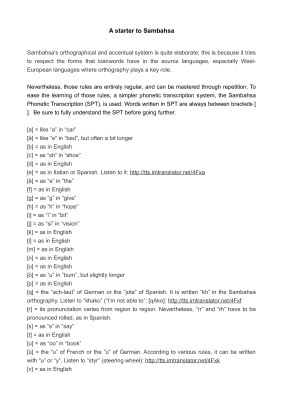Автор и выходные данные не указаны. Кол-во стр. 26 Данная книга -
частичный перевод целиком написанного на самбасе учебника Sambahsa
Euckbuck
Among IALs it is categorized as a worldlang. It is based on the Proto Indo-European language (PIE), with a highly simplified grammar. The language was first released on the Inteet in July 2007; prior to that, the creator claims to have worked on it for eight years. According to one of the rare academic studies addressing recent auxiliary languages, "Sambahsa has an extensive vocabulary and a large amount of leaing and reference material". The first part of the name of the language, Sambahsa, is taken from two Malay words, sama and bahsa which mean 'same' and 'language' respectively. Mundialect, on the other hand, is a result of combining two Romance words, mondial (worldwide) and dialect (dialect). Sambahsa tries to preserve the original spellings of words as much as possible and this makes its orthography complex, though still kept regular. There are four grammatical cases: nominative, accusative, dative and genitive. Sambahsa, though based on PIE, borrows a good proportion of its vocabulary from languages such as Arabic, Chinese, Indonesian, Swahili and Turkish, which belong to various other language families.
Among IALs it is categorized as a worldlang. It is based on the Proto Indo-European language (PIE), with a highly simplified grammar. The language was first released on the Inteet in July 2007; prior to that, the creator claims to have worked on it for eight years. According to one of the rare academic studies addressing recent auxiliary languages, "Sambahsa has an extensive vocabulary and a large amount of leaing and reference material". The first part of the name of the language, Sambahsa, is taken from two Malay words, sama and bahsa which mean 'same' and 'language' respectively. Mundialect, on the other hand, is a result of combining two Romance words, mondial (worldwide) and dialect (dialect). Sambahsa tries to preserve the original spellings of words as much as possible and this makes its orthography complex, though still kept regular. There are four grammatical cases: nominative, accusative, dative and genitive. Sambahsa, though based on PIE, borrows a good proportion of its vocabulary from languages such as Arabic, Chinese, Indonesian, Swahili and Turkish, which belong to various other language families.

